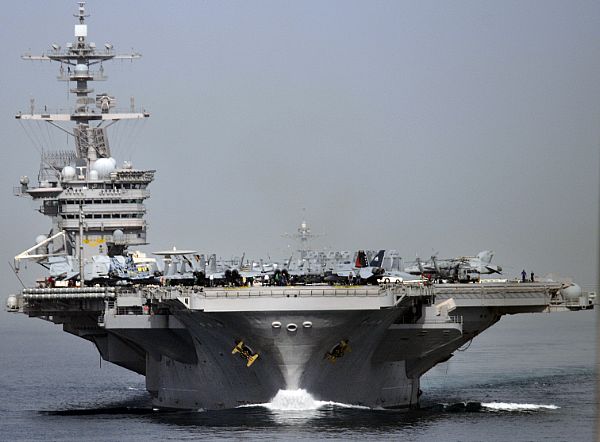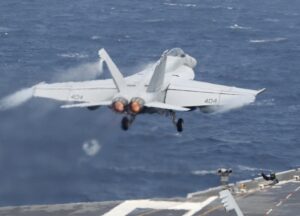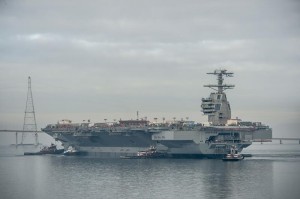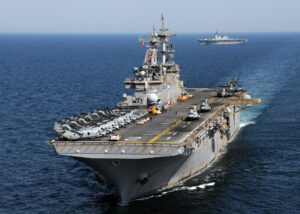‘Carrier Gap’ In Gulf Is A Symptom, Not A Crisis
Posted on

USS Carl Vinson transits the Strait of Hormuz
The geostrategic sky isn’t falling because the US won’t have an aircraft carrier in the Persian Gulf region for a period this fall. Land-based aircraft will do an excellent job of striking ISIL, analysts say, while smaller ships are better suited to combat Iran in the tight confines of the Gulf.
“This is not an example of American weakness,” said Tony Cordesman, the legendary military analyst at the Center for Strategic and International Studies. “You had a large carrier presence at one point because you were flying sorties into Afghanistan, [and] after a while people assume you have to do it because you’ve done it before.”
But the “carrier gap” is both a symbol and a symptom of deeper problems in Washington. “The Navy and Department of Defense need to work together to solve the tactical problem [in the Gulf], but Congress and the American people must solve the bigger strategic problem by providing our Navy with the resources it needs,” House seapower subcommittee chairman Randy Forbes said in a statement.

Rep. Randy Forbes (R-Va.)
The problems go beyond the size of the budget, however. They start with the chronic slowdowns in the weapons procurement process, which is late delivering the Navy’s newest carrier, the high-tech USS Gerald Ford. As a result the Navy is a flattop short: It has 10 instead of the required 11. And the 10 carriers it does have, like the rest of the fleet, are increasingly frayed by years of long deployments and maintenance shortcuts, aggravated by the 2013 budget cuts known as sequester, which may yet reoccur. Meanwhile, operational demands remain stubbornly high as conflicts refuse to end.
“It’s about the supply and demand of naval forces, plain and simple,” one Hill staffer says “The Navy just hasn’t been given the resources it needs to do what we’ve been asking of it in a sustainable manner. We went to 2.0 carrier presence [in the Gulf] around the same time that Congress passed the Budget Control Act, and now we’re paying the price.”
“It’s been coming for a long time,” Bryan Clark, a former advisor to the Chief of Naval Operations now with the Center for Strategic and Budgetary Assessments, believes. “This is indicative of the readiness challenges that the Navy is running into. They’re not going to be able to maintain the heel-to-toe carrier deployments,” which wear hard on ships and crews alike. “Eventually all that comes to roost and we’re going to have to a gap at some point so they can get the training and maintenance done.”

Navy F/A-18 Super Hornet launches from a carrier
“At some point, you’ve got to decrease the tempo on the force,” agreed Jerry Hendrix, a retired Navy captain at the Center for a New American Security. “We didn’t always have a 1.0 requirement for coverage of an aircraft carrier [constantly] in the Arabian Gulf. We went to that requirement after we started military operations in Afghanistan and Iraq.” With our ground presence in both countries way down, he said, “there’s going to be gaps there again.”
“One of the things to keep in perspective here,” Navy spokesman Lt. Timothy Hawkins told me, “is that when we responded to increased demand from the combatant commanders in fiscal years 2011, 2012, and 2013, we said at the time that in subsequent years we would have to recover our readiness. Ships have to be maintained [and] sailors have to be trained. We have to recover — this is where we are today.”
Just recently, the Navy had to reshuffle its carrier deployment schedule when the USS Eisenhower took longer than planned in maintenance, forcing the Truman to take its place. “There’s no direct causal linkage between Ike‘s delay and any subsequent gaps,” Hawkins said, but it shows how strained readiness has become.
There are three major factors behind the gap, Lt. Hawkins writes: “[1] increased COCOM [combatant commander] demand in previous years; [2] sequestration’s impact on our shipyards; [3] having a force structure of 10 instead of 11 carriers.”
The gap might close. If the President and the Secretary of Defense want a carrier somewhere, then they’ll get one.
That said, admirals from Chief of Naval Operations Jonathan Greenert on down have labored hard to shorten deployments and to increase time for maintenance and training. The current carrier in the Central Command theater, the Roosevelt, is on what’s scheduled to be an eight-month deployment — a month longer than called for in the Navy’s Optimized Fleet Response Plan.
Seven month deployments would be sustainable if the Navy could just get back to 11 carriers, Clark told me. “Even with this Optimized [Fleet Response Plan], which is a plan for seven-month deployments in a 36-month cycle… let me run a calculator here.” A minute of muttering and tapping later, Clark announced the 7-in-36 plan “gives you about 1.94 carriers deployed [at any given time] outside of the Pacific Command,” which has its own full-time carrier based in Japan.
“If the Ford had come out on time, we’d be at 11 carriers,” Clark said. “That one carrier makes a big difference when it comes to presence in Central Command.”

The new carrier USS Ford is afloat but unfinished.
The problems of the Ford are a much bigger factor in the carrier gap than the general issues with the budget.
“The blame lies with the carrier advocates and not with the budgeteers,” Cordesman told me. “They didn’t control cost, they didn’t control configuration, and they didn’t control time.”
The carrier’s design replaces traditional hydraulics and steam with electrical power, which should make maintenance much easier, but there’ve been costly and time-consuming complications getting the electromagnetic catapults and arresting cables to work.
Senate Armed Services chairman John McCain is so incensed over the Ford overruns that he’s questioned the entire design. “In view of the vital importance of aircraft carriers to national defense, the cost per ship, lack of competition, and history of cost overruns,” runs SASC report language accompanying the annual defense bill, “the committee directs a report, which examines potential requirements, capabilities, and alternatives for future development of aircraft carriers that would replace or supplement CVN–78 [Ford] class aircraft carriers.”

The USS Essex
Whether the US should build a smaller, more affordable class of carrier is a decades-long debate. (Just ask the Marines.) As a practical matter, the US already does have smaller flattops: the so-called “big deck” amphibious assault ships, which carry short-ranged jet fighters like the aging Harrier or the future F-35B, and which are as large as what most of our allies call carriers.
“We are not totally gapping the Arabian Gulf; we have an Essex-class [ship],” said Hendrix. “The USS Essex is as large as almost every other aircraft carrier in the world outside of the French Charles de Gaulle.“
Subscribe to our newsletter
Promotions, new products and sales. Directly to your inbox.
